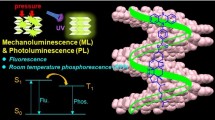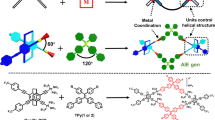Abstract
Circularly polarized luminescence (CPL) organic dyes are currently receiving a great interest, but there are still not many reported observations of CPL spectra of hydrophobic dyes from aqueous solution. We have prepared hydrophobic pyrene derivatives and dissolved them into aqueous solutions with γ-cyclodextrin (γ-CD) by using grinding technique. Among these derivatives, (pyrene-1-carbonyl)serine (PySer) forms a spatially restricted dimer in the hydrophobic chiral cavity of γ-CD and exhibits excimer emission with a high quantum yield of Φf = 0.68. In addition, circular dichroism and CPL signals were induced for the complex. The strong gCPL value of gCPL = + 2.2 × 10−3 was obtained, which may be attributed to the interaction between the hydroxyl groups in the side chain of PySer with those of γ-CD and it strengthens the chiral dimeric structure.
Graphic abstract










Similar content being viewed by others
References
Maeda, H., Bando, Y.: Recent progress in research on stimuli-responsive circularly polarized luminescence based on π-conjugated molecules. Pure Appl. Chem. 85, 1967–1978 (2013)
Sánchez Carnerero, E.M., Agarrabeitia, A.R., Moreno, F., Maroto, B.L., Muller, G., Ortiz, M.J., de la Moya, S.: Circularly polarized luminescence from simple organic molecules. Chem. Eur. J. 21, 13488–13500 (2015)
Kumar, J., Nakashima, T., Kawai, T.: Circularly polarized luminescence in chiral molecules and supramolecular assemblies. J. Phys. Chem. Lett. 6, 3445–3452 (2015)
Longhi, G., Castiglioni, E., Koshoubu, J., Mazzeo, G., Abbate, S.: Circularly polarized luminescence: A review of experimental and theoretical aspects. Chirality 28, 696–707 (2016)
Tanaka, H., Inoue, Y., Mori, T.: Circularly polarized luminescence and circular dichroisms in small organic molecules: Correlation between excitation and emission dissymmetry factors. ChemPhotoChem 2, 386–402 (2018)
Pop, F., Zigon, N., Avarvari, N.: Main-group-based electro- and photoactive chiral materials. Chem. Rev. 119, 8435–8478 (2019)
Sato, T., Tajima, N., Ueno, H., Harada, T., Fujiki, M., Imai, Y.: Binaphthyl luminophores with triphenylsilyl groups: sign inversion of circularly polarized luminescence and circular dichroism. Tetrahedron 72, 7032–7038 (2016)
Kaji, D., Okada, H., Hara, N., Kondo, Y., Suzuki, S., Miyasaka, M., Fujiki, M., Imai, Y.: Non-classically controlled sign in a 1.6 tesla magnetic circularly polarized luminescence of three pyrenes in a chloroform and a PMMA film. Chem. Lett. 49, 674–676 (2020)
Kitatobe, T., Mimura, Y., Tsujimoto, S., Tajima, N., Fujiki, M., Imai, Y.: Circularly polarized luminescence from open- and closed-style axially chiral amphipathic binaphthyl fluorophores in water. Tetrahedron 73, 6856–6862 (2017)
Okano, K., Taguchi, M., Fujiki, M., Yamashita, T.: Circularly polarized luminescence of rhodamine B in a supramolecular chiral medium formed by a vortex flow. Angew. Chem. Int. Ed. 50, 12474–12477 (2011)
Bradberry, S., Savyasachi, A., Peacock, R., Gunnlaugsson, T.: Quantifying the formation of chiral luminescent lanthanide assemblies in an aqueous medium through chiroptical spectroscopy and generation of luminescent hydrogels. Faraday Discuss. 185, 413–431 (2015)
Wu, T., Prusa, J., Kessler, J., Dracinsky, M., Valenta, J., Bour, P.: Detection of sugars via chirality induced in europium(III) compounds. Anal. Chem. 88, 8878–8885 (2016)
Hayashi, K., Miyaoka, Y., Ohishi, Y., Uchida, T., Iwamura, M., Nozaki, K., Inouye, M.: Observation of circularly polarized luminescence of the excimer from two perylene cores in the form of [4]rotaxane. Chem. Eur. J. 24, 14613–14616 (2018)
Kobayashi, N., Saito, R., Hino, H., Hino, Y., Ueno, A., Osa, T.: Fluorescence and induced circular dichroism studies on host–guest complexation between γ-cyclodextrin and pyrene. J. Chem. Soc., Perkin Trans. 2, 1031–1035 (1983)
Kano, K., Matsumoto, H., Hashimoto, S., Sisido, M., Imanishi, Y.: A chiral pyrene excimer in γ-cyclodextrin cavity. J. Am. Chem. Soc. 107, 6117–6118 (1985)
Kano, K., Matsumoto, H., Yoshimura, Y., Hashimoto, S.: Binding sites of pyrene and related compounds and chiral excimer formation in the cavities of cyclodextrins and branched cyclodextrins. J. Am. Chem. Soc. 110, 204–209 (1988)
Ueno, A., Suzuki, I., Osa, T.: Formation of pyrene excimer in an association dimer of pyrene-appended γ-cyclodextrin. J. Chem. Soc. Chem. Commun. (1988). https://doi.org/10.1039/C39880001373
Ohishi, Y., Inouye, M.: Circularly polarized luminescence from pyrene excimers. Tetrahedron Lett. 60, 151232 (2019)
Inouye, M., Hayashi, K., Yonenaga, Y., Itou, T., Fujimoto, K., Uchida, T., Iwamura, M., Nozaki, K.: A doubly alkynylpyrene-threaded [4] rotaxane that exhibits strong circularly polarized luminescence from the spatially restricted excimer. Angew. Chem. Int. Ed. 53, 14392–14396 (2014)
Harada, A., Nozakura, S.: Cooperative inclusion of sodium 1-pyrenesulfonate by γ-cyclodextrin. Polym. Bull. 8, 141–146 (1982)
Mura, P.: Analytical techniques for characterization of cyclodextrin complexes in the solid state: A review. J. Pharm. Biomed. Anal. 113, 226–238 (2015)
Jug, M., Mura, P.A.: Grinding as solvent-free green chemistry approach for cyclodextrin inclusion complex preparation in the solid state. Pharmaceutics 10, 189–210 (2018)
Tsuchiya, Y., Shiraki, T., Matsumoto, T., Sugikawa, K., Sada, K., Yamano, A., Shinkai, S.: Supramolecular dye inclusion single crystals created from 2,3,6-trimethyl‐β‐cyclodextrin and porphyrins. Chem. Eur. J. 18, 456–465 (2012)
Kano, K., Nishiyabu, R., Asada, T., Kuroda, Y.: Static and Dynamic Behavior of 2:1 Inclusion Complexes of Cyclodextrins and Charged Porphyrins in Aqueous Organic Media. J. Am. Chem. Soc. 124, 9937–9944 (2002)
Kawaguchi, Y., Harada, A.: An Electric Trap: A New Method for Entrapping Cyclodextrin in a Rotaxane Structure. J. Am. Chem. Soc. 122, 3797–3798 (2000)
Kano, K., Takenoshita, I., Ogawa, T.: Fluorescence quenching of pyrene and naphthalene in aqueous cyclodextrin solutions. Evidence of three-component complex formation. J. Phys. Chem. 86, 1833–1838 (1982)
Frisch, M.J., Trucks, G.W., Schlegel, H.B., Scuseria, G.E., Robb, M.A., Cheeseman, J.R., Scalmani, G., Barone, V., Petersson, G.A., Nakatsuji, H., Li, X., Caricato, M., Marenich, A., Bloino, J., Janesko, B.G., Gomperts, R., Mennucci, B., Hratchian, H.P., Ortiz, J.V., Izmaylov, A.F., Sonnenberg, J.L., Williams-Young, D., Ding, F., Lipparini, F., Egidi, F., Goings, J., Peng, B., Petrone, A., Henderson, T., Ranasinghe, D., Zakrzewski, V.G., Gao, J., Rega, N., Zheng, G., Liang, W., Hada, M., Ehara, M., Toyota, K., Fukuda, R., Hasegawa, J., Ishida, M., Nakajima, T., Honda, Y., Kitao, O., Nakai, H., Vreven, T., Throssell, K., Montgomery, J.A., Jr., Peralta, J.E., Ogliaro, F., Bearpark, M., Heyd, J.J., Brothers, E., Kudin, K.N., Staroverov, V.N., Keith, T., Kobayashi, R., Normand, J., Raghavachari, K., Rendell, A., Burant, J.C., Iyengar, S.S., Tomasi, J., Cossi, M., Millam, J.M., Klene, M., Adamo, C., Cammi, R., Ochterski, J.W., Martin, R.L., Morokuma, K., Farkas, O., Foresman, J.B., Fox, D.J.: Gaussian 16, Revision D.01. Gaussian Inc., Wallingford CT (2016)
Adamo, C., Jacquemin, D.: The calculations of excited-state properties with time-dependent density functional theory. Chem. Soc. Rev. 42, 845–856 (2013)
Lee, C., Yang, W., Parr, R.G.: Development of the colle-salvetti correlation-energy formula into a functional of the electron density. Phys. Rev. B37, 785–789 (1988)
Becke, A.D.: Density-functional thermochemistry. III. The role of exact exchange. J. Chem. Phys. 98(7), 5648–5646 (1993)
Cances, E., Mennucci, B., Tomasi, J.: A new integral equation formalism for the polarizable continuum model: Theoretical background and applications to isotropic and anisotropic dielectrics. J. Chem. Phys. 107, 3032–3041 (1997)
Cossi, M., Barone, V., Mennucci, B., Tomasi, J.: Ab initio study of ionic solutions by a polarizable continuum dielectric model. Chem. Phys. Lett. 286, 253–260 (1998)
Mennucci, B., Tomasi, J.: Continuum solvation models: A new approach to the problem of solute’s charge distribution and cavity boundaries. J. Chem. Phys. 106, 5151–5158 (1997)
Berova, N., Nakanishi, K., Woody, R.W. (eds.): Circular Dichroism Principles and Applications, 2nd edn. Wiley-VCH, New York (2004)
Zhang, Y., Yang, D., Han, J., Zhou, J., Jin, Q., Liu, M., Duan, P.: Circularly polarized luminescence from a pyrene-cyclodextrin supra-dendron. Langmuir 34, 5821–5830 (2018)
Schneider, H.J., Hacket, F., Rüdiger, V.: NMR studies of cyclodextrin and cyclodextrin complexes. Chem. Rev. 98, 1755–1785 (1998)
Acknowledgements
This work is supported by JSPS KAKENHI Grant Number JP20K05567, the “ZE Research Program IAE(ZE2021A-04)”, the Murata Science Foundation, the Nara Women’s University Intramural Grant for Project Research and JST CREST (JPMJCR2001), Japan. The computations were performed using the resources at the Research Center for Computational Science, Okazaki, Japan. We thank Dr. Naokazu Yoshikawa for his assistance of X-ray analysis.
Author information
Authors and Affiliations
Corresponding author
Ethics declarations
Conflict of interest
The authors declare no conflict of interest.
Additional information
Publisher’s Note
Springer Nature remains neutral with regard to jurisdictional claims in published maps and institutional affiliations.
Supplementary Information
Below is the link to the electronic supplementary material.
Rights and permissions
About this article
Cite this article
Sawai, M., Matsumoto, S., Mimura, Y. et al. Circularly polarized luminescence (CPL) characteristics of hydrophobic pyrene derivatives/γ-cyclodextrin (γ-CD) complexes in aqueous solution dissolved by grinding. J Incl Phenom Macrocycl Chem 102, 133–142 (2022). https://doi.org/10.1007/s10847-021-01108-z
Received:
Accepted:
Published:
Issue Date:
DOI: https://doi.org/10.1007/s10847-021-01108-z




